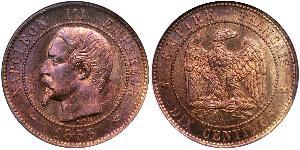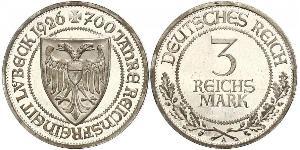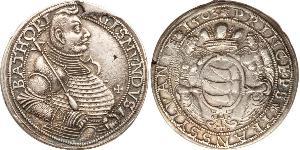(sold for $37.0)
1568/1975, German States, Aachen (Free City). Silver Thaler. Medallic Restrike!
Mint place: Aachen Condition: About XF! Denomination: Thaler Mint year: 1568 (re-struck during 1975!) Reference: KM-MB#8 var. here a medallic re-strike, made during 1975! Material: Silver (.800) Weight: 24.83gm Diameter: 42mm
Aachen also known as Bad Aachen (Ripuarian: Óche, Limburgish: Aoke, French: Aix-La-Chapelle, Italian: Aquisgrana, Dutch: Aken, Spanish: Aquisgrán, Latin: Aquisgranum) is a spa town in North Rhine-Westphalia, Germany. Sometimes in English (especially in old use), the city is referred to as Aix-la-Chapelle. Aachen was a favoured residence of Charlemagne, and later the place of coronation of the German emperors. Geographically, Aachen is the westernmost city of Germany, located along its borders with Belgium and the Netherlands, 61 km (38 mi) west-southwest of Cologne. It is located within a coal-mining region, and this fact was important in its economic history.
As an imperial city, Aachen held certain political advantages that allowed it to remain independent of the troubles of Europe for many years. It remained a direct vassal of the Holy Roman Empire throughout most of the Middle Ages. It also was the site of many important church councils. These included the Council of 836, and the Council of 1166, a council convened by the antipope Paschal III. From the early 16th century, Aachen started losing its power and influence. It started with the crowning of emperors occurring not in Aachen but in Frankfurt, followed by the religious wars, and the great fire of 1656. It then culminated in 1794, when the French, led by General Charles Dumouriez, occupied Aachen.
Aachen became attractive as a spa by the middle of the 17th century, not so much because of the effects of the hot springs on the health of its visitors but because Aachen was then — and remained well into the 19th century — a place of high-level prostitution in Europe. Traces of this hidden agenda of the city's history is found in the 18th-century guidebooks to Aachen as well as to the other spas; the main indication for visiting patients, ironically, was syphilis; only by the end of the 19th century had rheuma become the most important object of cures at Aachen and Burtscheid. Aachen was chosen as the site of several important congresses and peace treaties: the first congress of Aachen (often referred to as Congress of Aix-la-Chapelle in English) in 1668, leading to the First Treaty of Aachen in the same year which ended the War of Devolution. The second congress ended with the second treaty in 1748, finishing the War of the Austrian Succession.
Only 1$ shipping for each additional coin purchased!

|
Posted by:
anonymous 2017-01-13 |
1 Thaler Austrian Empire (1804-1867) Silver Francis II, Holy ...
group has 92 coins / 90 prices
⇑
1 Ducat Kingdom of the Netherlands (1815 - ) Gold
group has 15 coins / 14 prices
⇑
















-300-150-VTsKX9IS6aAAAAFZr5S1mgkc.jpg)

-300-150-S5IKbzbiDHkAAAFLS6rk0KRZ.jpg)






